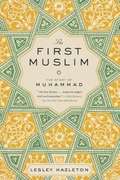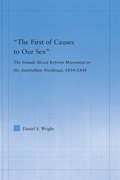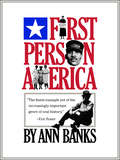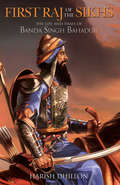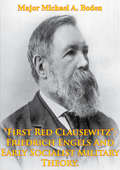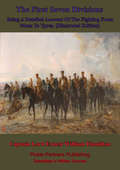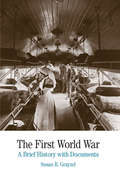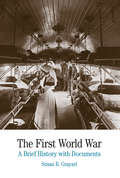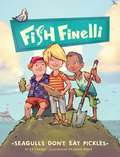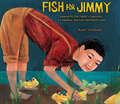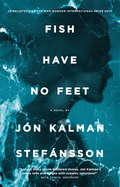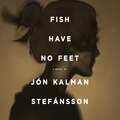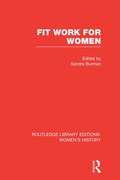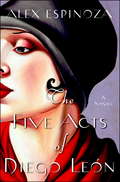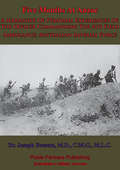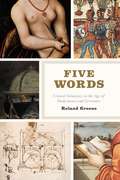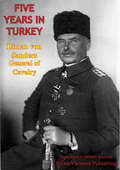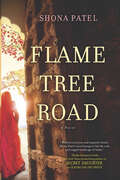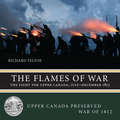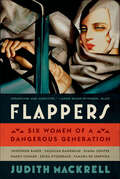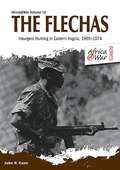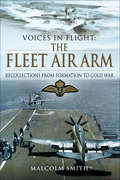- Table View
- List View
The First Muslim
by Lesley HazletonThe extraordinary life of the man who founded Islam, and the world he inhabited--and remade. Muhammad's was a life of almost unparalleled historical importance; yet for all the iconic power of his name, the intensely dramatic story of the prophet of Islam is not well known. In The First Muslim, Lesley Hazleton brings him vibrantly to life. Drawing on early eyewitness sources and on history, politics, religion, and psychology, she renders him as a man in full, in all his complexity and vitality. Hazleton's account follows the arc of Muhammad's rise from powerlessness to power, from anonymity to renown, from insignificance to lasting significance. How did a child shunted to the margins end up revolutionizing his world? How did a merchant come to challenge the established order with a new vision of social justice? How did the pariah hounded out of Mecca turn exile into a new and victorious beginning? How did the outsider become the ultimate insider? Impeccably researched and thrillingly readable, Hazleton's narrative creates vivid insight into a man navigating between idealism and pragmatism, faith and politics, nonviolence and violence, rejection and acclaim. The First Muslim illuminates not only an immensely significant figure but his lastingly relevant legacy.
The First of Causes to Our Sex: The Female Moral Reform Movement in the Antebellum Northeast, 1834-1848 (Studies in American Popular History and Culture)
by Daniel S. WrightThe First of Causes to Our Sex is a study of the first movement in the United States for social change by and for women. Female moral reform in the 1830s and '40s was a campaign to abolish sexual vice and the sexual double standard, and to promote sexual abstinence among the young as they entered the marriage market. The movement has earned a place in U.S. women's history, but most research has focused on it as an urban phenomenon, and sought its significance in relation to the cause of women's rights or to the regulation of prostitution. This study explores the appeal of moral reform to rural women, who were the vast majority of its constituency, and sees it as a response to seminal changes in family formation and family size in the context of an increasingly market-oriented and mobile society. It was led by Yankee women who were fired by Second Great Awakening revivals and supported by reformist clergy.
The First of July
by Elizabeth SpellerOn July 1st, 1913, four very different men are leading four very different lives.Exactly three years later, it is just after seven in the morning, and there are a few seconds of peace as the guns on the Somme fall silent and larks soar across the battlefield, singing as they fly over the trenches. What follows is a day of catastrophe in which Allied casualties number almost one hundred thousand. A horror that would have been unimaginable in pre-war Europe and England becomes a day of reckoning, where their lives will change forever, for Frank, Benedict, Jean-Batiste, and Harry.Elizabeth Speller once again sublimely captures the dangerously romantic atmosphere of war-torn Europe in her latest novel that will leave critics and readers astounded.
First-Person America
by Ann BanksBetween 1938 and 1942 the Federal Writers' Project set out to create a first-person portrait of America by sending young writers--many of whom later became famous--around the country to interview people from all occupations and backgrounds. This book presents 80 of these diverse life histories, including the stories of a North Carolina patent-medicine pitchman, a retired Oregon prospector, a Bahamian midwife from Florida, a Key West smuggler, recent immigrants to New York, and Chicago jazz musicians. Historian Eric Foner called First-Person America "the finest example yet of an increasingly important genre of oral history."
First Raj of the Sikhs: The Life and Times of Banda Singh Bahadur
by Harish DhillonBanda Singh Bahadur appeared in Sikh history for a relatively short period (1708-1716) but, after the Sikh gurus, influenced it more significantly than any other individual. Banda Singh Bahadur is among the most colourful and fascinating characters in Sikh history. From an ascetic he was transformed into Guru Gobind Singh’s most trusted disciple. So much so that when the seriously injured guru could not lead his Sikh army against the Mughal forces, he appointed Banda Singh Bahadur as his deputy. As proof of this appointment he gave Banda his sword, a mighty bow, arrows from his own quiver, his battle standard and his war drum. Banda rode out from Nanded (where Guru Gobind Singh passed away; now in Maharashtra) at the head of a small band of Sikhs, which, by the time it reached the Punjab, had grown into a formidable army. Over the next few years his exploits against the Mughal rulers, both in pitched battles and in skirmishes, became the stuff of legends. He became the first of many legendary Sikh generals, famous both for their personal heroic courage and their skill in warfare. His many encounters with the Mughal rulers eroded the very foundation of the Mughal empire and ensured its quick demise. As he said when questioned on what he had achieved: ‘I have ensured that never again will the crown sit easily on the Mughal emperor’s head.’ He also prepared the coming generations of Sikhs for future conflicts, which later greatly helped Maharaja Ranjit Singh in creating a Sikh empire. Banda was a true leader who led from the front, not only in the battlefield but also in civil administration. He established a secular government which swept aside 700 years of slavery and the myth of domination by foreign powers, proclaimed freedom of worship, allowed the people to follow professions of their choice and stopped forcible marriages even while recovering abducted women for return to their families. His land revolution abolished zamindari in parts of North India, thereby redistributing land equally amongst the tillers. This book seeks to tell the story of this remarkable and brave man and his equally remarkable ahievements. Perhaps, the finest of Banda Singh Bahadur’s biographies.
“First Red Clausewitz”: Friedrich Engels And Early Socialist Military Theory
by Major Michael A. BodenBetween the European revolutions of the mid-nineteenth century and the Franco-Prussian War in 1870, Friedrich Engels functioned as a writer, analyst, and critic concerning military affairs. His most essential commentaries were published, disseminated, and internalized by supporters of the proletarian revolution. This project concentrates on the tactical, operational, and technical aspects of Engels' military thought and the development of his concepts from his earliest writings until the Franco-Prussian War. Historians and commentators routinely ignore these aspects of military theory in examinations of Engels' work. This project will demonstrate that Engels possessed are markable level of military knowledge and a degree of insight at the operational and tactical levels of warfare and that that he should be considered not only as an important social and economic thinker, but also among the most significant contributors to the field of nineteenth-and twentieth-century military history and theory. Engels' most significant contributions exist in the manner by which he, as a key member of the socialist leadership in the nineteenth century, integrated the concept of armed insurgency into the conduct of a proletarian revolution. By drawing on the experiences of the French Revolution and the wars of Napoleon, and then the impact of mass-industrialization, Engels was the first person to specifically incorporate a force dynamic into the trajectory of a socialist revolution. Despite the fact that he was a civilian with no formal military training beyond service as a Prussian artilleryman in 1842, his contributions to the field of revolutionary military theory earn him distinction as one of the most important socialist writers of the nineteenth century.
The First Seven Divisions, Being A Detailed Account Of The Fighting From Mons To Ypres. [Illustrated Edition]
by Captain Lord Ernest William HamiltonThe opening of the First World War pitted the huge continental armies against each other; massed conscription filled their ranks, Britain's soldiers, however, were to a man volunteer, long-service professionals. Disciplined, few in number but thoroughly trained to shoot 15 aimed shoots in a "mad-minute", they were but few in number. The German forces they faced on the Western Front were counted by the number of their armies, the British forces could only put seven divisions in the field initially.In the face of overwhelming numbers the British soldiers gave a good account of themselves and held up the German advance during the crucial opening phases of the campaign alongside their French allies. The German High command had not counted on such stubborn resistance such a spanner in the works were they and their fighting prowess that the Kaiser himself paid the brave few the ultimate compliment-- "It is my Royal and Imperial command that you concentrate your energies, for the immediate present, upon one single purpose, and that is that you address all your skill and all the valour of my soldiers to exterminate first the treacherous English and walk over General French's contemptible little army."--Kaiser Wilhelm 19th August 1914.Written by Lord Hamilton, at the time a Captain in the 11th Hussars, this is an excellent and highly detailed account of the early months of the First World War on the British Front.Author -- Captain Lord Ernest William Hamilton (1858-1939)Text taken, whole and complete, from the edition published in New York, E.P. Dutton and company 1916Original Page Count - 338 pages.Maps -- 8 detailed maps.
First Sinners (The Sinners Club)
by Kate PearceTheir identities a secret, they are men of mystery with hidden pasts and dark passions. Welcome to the Sinners Club...Secret DesiresFaith Pelly is tired of being the responsible daughter. She longs for adventure with a man who will introduce her to the secrets of carnal desire. But she never dreams she will meet the Savage Rake who flirts with her, seduces her and takes her as his own...Dark SecretsAsked to investigate charges of treason, the Earl of Westbrook attends a house party determined to discover the truth. That includes using all his sensual wiles on the lovely Miss Pelly, a beguiling young woman eager for erotic excitement with a man who will fulfill all her secret fantasies. And he plans on being that man...Sizzling Praise for Kate Pearce"Sinfully hot. If you like your romance hot as you return to the Regency era, where behind the scenes anything goes, then grab Simply Carnal for your reading pleasure." --Romance Reviews Today"The passion of Pearce's erotic tale is focused and intense.... Their sex encounters and fantasies...steam up the pages." --Romantic Times on Simply Shameless28,000 Words
The First World War: A Brief History With Documents (Seminar Studies)
by Susan R. GrayzelFerocious and all encompassing, the First World War touched countless lives in Europe and far beyond. In this volume, Susan R. Grayzel explores the unprecedented nature of modern “Total War,” and outlines the origins, experiences, and legacies of the war through — and beyond — Europe and the West. The introduction offers important insights into the cultural, political, and psychological landscape from which the war emerged, as well as a thoughtful examination of the conduct of the war and its aftermath. A wide array of documents, ranging from nationalist propaganda and diplomatic agreements to poetry and intimate letters and journals, reveal the far-reaching causes and consequences of this total war, and offer unique perspectives from voices sometimes overlooked in the study of the war — including colonial soldiers, contemporary psychologists, artists, protestors, and women at the home front and the front lines. Incisive document headnotes, maps, a chronology, questions to consider, and a bibliography enrich students’ understanding of this fateful period.
The First World War: A Brief History With Documents (Seminar Studies)
by Susan GrayzelThe First World War
First World War Nursing: New Perspectives (Routledge Studies in Modern History #11)
by Christine E. Hallett Alison S. FellThis book brings together a collection of works by scholars who have produced some of the most innovative and influential work on the topic of First World War nursing in the last ten years. The contributors employ an interdisciplinary collaborative approach that takes into account multiple facets of Allied wartime nursing: historical contexts (history of the profession, recruitment, teaching, different national socio-political contexts), popular cultural stereotypes (in propaganda, popular culture) and longstanding gender norms (woman-as-nurturer). They draw on a wide range of hitherto neglected historical sources, including diaries, novels, letters and material culture. The result is a fully-rounded new study of nurses’ unique and compelling perspectives on the unprecedented experiences of the First World War.
Fish Finelli: Seagulls Don't Eat Pickles
by Erica Farber Jason BeeneWhen bully Bryce Billings bets Fish Finelli that he can't find Captain Kidd's legendary long-lost treasure, Fish and his friends embark on a quest to find real-life pirate treasure. Between sneaking into the library to track down Captain Kidd's map, stowing away on a boat, and trespassing on an island, Fish and his friends have their work cut out for them. But will Fish actually be able to find Captain Kidd's booty and win the bet? Appropriate for both boys and girls, this first book inthe Fish Finelli series will inspire readers to use their imaginations, learn about the world around them, and appreciate the bonds of friendship.
Fish for Jimmy: Inspired by One Family's Experience in a Japanese American Internment Camp
by Katie YamasakiFor two boys in a Japanese American family, everything changed when Japan bombed Pearl Harbor and the United States went to war. With the family forced to leave their home and go to an internment camp, Jimmy loses his appetite. Older brother Taro takes matters into his own hands and, night after night, sneaks out of the camp and catches fresh fish for Jimmy to help make him strong again. This affecting tale of courage and love is an adaptation of the author's true family story, and includes a letter to readers with more information about the historical background and inspiration.
Fish Have No Feet
by Jón Kalman StefánssonLonglisted for the Man Booker International Prize 2017Keflavik: a town that may be the darkest place in Iceland, surrounded by black lava fields, hemmed in by a sea that may not be fished, and site of the U.S. military base, whose influences shaped Icelandic culture from the '50s to the dawning of the new millennium. Ari - a writer and publisher - lands back in Keflavik from Copenhagen. His father is dying, and he is flooded by memories of his youth in the '70s and '80s, listening to Pink Floyd and the Beatles, raiding American supply lorries and discovering girls. And one girl he could never forget. Layered through Ari's story is that of his grandparents in a village on the eastern coast, a world away from modern Keflavik. For his grandfather Oddur, life at sea was a destiny; for Margrét its elemental power brings only loneliness and fear. Both the story of a singular family and an epic that sparkles with love, pain and lifelong desire - with all of human life - Fish have no Feet is a novel of profound beauty and wisdom by a major international writer.By the author of the acclaimed trilogy, Heaven and Hell, The Sorrow of Angels and The Heart of Man.
Fish Have No Feet
by Jón Kalman StefánssonKeflavik: a town that has been called the darkest place in Iceland, surrounded by black lava fields, hemmed in by a sea that may not be fished. Its livelihood depends entirely on a U.S. military base, a conduit for American influences that shaped Icelandic culture and ethics from the 1950s to the dawning of the new millennium. It is to Keflavik that Ari - a writer and publisher - returns from Copenhagen at the behest of his dying father, two years after walking out on his wife and children. He is beset by memories of his youth, spent or misspent listening to Pink Floyd and the Beatles, fraternising with American servicemen - who are regarded by the locals with a mixture of admiration and contempt - and discovering girls. There is one girl in particular he could never forget - her fate has stayed with him all his life.Lost in grief and nostalgia, he is also caught up in the story of how his grandparents fell in love in Nordfjordur on the eastern coast, a fishing village a world away from modern Keflavik, at time when the old ways still held sway. Their tragic love affair unfolded against the backdrop of Iceland's harsh nature and unforgiving elements.Fish have no Feet is at once the story of a singular family and an epic of Icelandic history and culture. It offers an unique insight into modern Iceland, and the ways in which it has been shaped by outside influences. A sparkling novel of love, pain, loss and lifelong desire that marries the poetic, elemental style of Heaven and Hell, The Sorrow of Angels and The Heart of Man to a modern frame of reference and sensibility.(P)2016 W F Howes Ltd
Fit Work for Women: Women's History: Fit Work For Women (Routledge Library Editions: Women's History)
by Sandra BurmanThis book presents a collection of papers which discuss the origins of the domestic ideal and its effects on activities usually undertaken by women: not only on women’s wage work, but also on activities either not defined as work or accorded an ambiguous status. It discusses the formation of the ideology of domesticity, philanthropy and its effects on official policy and on women, landladies in the nineteenth and twentieth centuries, working-class radical suffragists, and Labour Party and trade union attitudes to feminists. Modern society of 1979, when the book was first published, is analysed in a discussion of militancy and acquiescence among women wage workers, a look at how and why the legal system reinforces activity specialisation according to gender, and an examination of why both pre-pre-war capitalism and the modern Welfare State have been unable to meet the needs of dependents. This collection reflects the increasing recognition that in order to understand women’s roles today, it is necessary to examine not only their current manifestations, but also their origins and early development.
The Five Acts of Diego Leon
by Alex EspinozaAcclaimed author Alex Espinoza, whose writing Lisa See has called "fresh, magical, beautiful, and evocative," returns with a captivating, unforgettable novel set in Hollywood's Golden Age, as a gifted and determined young man leaves Mexico--and everything he's ever known--to follow his dreams. Growing up in a rural village at the height of the Mexican Revolution, Diego León has many first loves: singing, dancing, and hearing the stories of his ancestors, the P'urhépecha. But when tragedy strikes, young Diego is sent to the city to live with his aristocratic grandparents, who insist he forget his roots and groom him to take over the family business. Under pressure to enter a profession--and a life--he cares nothing for, and haunted by the violence once again erupting all around him, Diego flees his war-torn country to forge his own destiny. Diego arrives in Hollywood in 1927, when silent films are giving way to talkies, Prohibition is in full swing, and "Latin lover" types are sought out even as they are looked down upon. Working his way up in the movie business with talent and ingenuity, Diego soon figures out that getting one's face on the silver screen has as much to do with what goes on behind the camera as what goes on in front of it. But the closer Diego comes to stardom, the more he finds that the past is not so easily escaped, as he is drawn again and again to the painful legacy of history and the wounds of his homeland. A sweeping, sensual novel of love, ambition, and identity, The Five Acts of Diego León bears all the marks of a classic Hollywood story: romance, betrayal, glamour, and an underdog hero to root for till the end."An elegant, startling vision of a Mexican in America, The Five Acts of Diego León proclaims the ascendance of a unique new talent, Alex Espinoza--a Chicano in America certain to surpass the fame of his novel's silent Hollywood hero. Espinoza takes our literature from a mute, black-and-white era to a national stage with full-spectrum color, in high-tech surround sound."--Dagoberto Gilb, author of Before the End, After the Beginning
Five Months At Anzac - [Illustrated Edition]: A Narrative Of Personal Experiences Of The Officer Commanding The 4th Field Ambulance, Australian Imperial Force
by Dr M. D. C. M. G. M. L. C Joseph Lieve BeestonIllustrated With the Gallipoli Campaign Pack - 71 photos and 33 mapsThe Gallipoli Peninsular in 1915 was an awful place to be an Allied soldier, for the Australians who had travelled thousands of miles to answer the call of their mother country it must have seemed like hell. Overlooked by intrenched Turkish and German soldiers, the narrow strip of land that they lived on was hard won with blood, the air whistled with shot and shell day in and day out. For Dr Joseph Beeston, a native of Newcastle New South Wales, his duty was the wounded of the Anzac forces which he tended with great care and skill. As he records in his memoirs of Gallipoli the fighting was tough and the conditions even worse, but despite all this he and his comrades kept their wry sense of humour. He was always cheered by his fellow Anzac soldiers and dedicated his book of anecdotes to them; stating that "One never ceased admiring our men, and their cheeriness under these circumstances and their droll remarks caused us many a laugh."A lively and engaging memoir from an Anzac veteran.
Five Words: Critical Semantics in the Age of Shakespeare and Cervantes
by Roland GreeneBlood. Invention. Language. Resistance. World. Five ordinary words that do a great deal of conceptual work in everyday life and literature. In this original experiment in critical semantics, Roland Greene considers how these words changed over the course of the sixteenth century and what their changes indicate about broader forces in science, politics, and other disciplines. Rather than analyzing works, careers, or histories, Greene discusses a broad swath of Renaissance and transatlantic literature—including Shakespeare, Cervantes, Camões, and Milton—in terms of the development of these five words. Aiming to shift the conversation around Renaissance literature from current approaches to riskier enterprises, Greene also proposes new methods that take advantage of digital resources like full-text databases, but still depend on the interpreter to fashion ideas out of ordinary language. Five Words is an innovative and accessible book that points the field of literary studies in an exciting new direction.
Five Years In Turkey [Illustrated Edition]
by Lieutenant-General Otto Liman Von Sanders Carl ReichmannNumerous maps, portraits and plans."War memoirs of Liman von Sanders, the German General who brilliantly commanded the Turkish defence at Gallipoli in 1915, before being defeated by Allenby in Palestine. Written while a post-war P.O.W. of the British in Malta.Otto Liman von Sanders (1855 - 1929) will always be associated with the Dardanelles campaign in which he commanded the Turkish Fifth Army, the army that defended Gallipoli, defeated the allied invasion and, after a campaign lasting some eight months (April-December 1915) forced the Allies to give up and withdraw. He was a cavalry officer who was commanding the German 22nd Division in Cassel when, in June 1913, he was offered the post of Chief of a German Military Mission in Turkey: he accepted and took up his post in December of that year and took over command of the Turkish First Army Corps, in Constantinople. Three months later, March 1914, he was given command of the Turkish Fifth Army defending Gallipoli and as such his version of events is of considerable interest to the history of that campaign. He later (1918) commanded the combined Turkish/German Yilderim force in Palestine where he was defeated by the greatly superior forces of Allenby. This account is based on notes written up in Malta where he was detained for some six months in 1919 before being permitted to return to Germany."-N&M Print Version
Flame Tree Road: A Novel
by Shona PatelFrom the acclaimed author of Teatime for the Firefly comes the story of a man with dreams of changing the world, who finds himself changed by love 1870s India. In a tiny village where society is ruled by a caste system and women are defined solely by marriage, young Biren Roy dreams of forging a new destiny. When his mother suffers the fate of widowhood-shunned by her loved ones and forced to live in solitary penance-Biren devotes his life to effecting change. Biren's passionate spirit blossoms as wildly as the blazing flame trees of his homeland. With a law degree, he goes to work for the government to pioneer academic equality for girls. But in a place governed by age-old conventions, progress comes at a price, and soon Biren becomes a stranger among his own countrymen. Just when his vision for the future begins to look hopeless, he meets Maya, the independent-minded daughter of a local educator, and his soul is reignited. It is in her love that Biren finally finds his home, and in her heart that he finds the hope for a new world.
The Flames of War: The Fight for Upper Canada, July—December 1813
by Richard FeltoeThe third in a series of unique surveys of the battles in the War of 1812. In April 1813 the Americans launched a new campaign to conquer Upper Canada, after their failure to do so in 1812. However, following initial victories, the U.S. assault stalled as a combined force of British regulars, Canadian militia, and Native allies counterattacked, throwing the Americans entirely onto the defensive by the end of June. During the next six months, this seesaw of military advantage was repeated again and again as each side escalated its commitment of men and resources and fought to gain the "final" victory. Unfortunately, this also brought with it an increasing level of destruction and hardship suffered by armies and civilian populations on both sides of the border. Numerous images of locations at the time are counterpointed with modern pictures taken from the same perspective to give a true then-and-now effect. Maps are also included to trace the course of individual battles stage by stage, while placing and moving the shifting formations of troops across a geographically accurate battlefield. This third volume in the six-part series Upper Canada Preserved — War of 1812 recounts the dramatic and destructive campaigns in the last six months of 1813 as the Americans continued their remounted attack on Upper Canada.
Flappers: Six Women of a Dangerous Generation
by Judith MackrellBy the 1920s, women were on the verge of something huge. Jazz, racy fashions, eyebrowraising new attitudes about art and sex—all of this pointed to a sleek, modern world, one that could shake off the grimness of the Great War and stride into the future in one deft, stylized gesture. The women who defined this the Jazz Age—Josephine Baker, Tallulah Bankhead, Diana Cooper, Nancy Cunard, Zelda Fitzgerald, and Tamara de Lempicka—would presage the sexual revolution by nearly half a century and would shape the role of women for generations to come.In Flappers, the acclaimed biographer Judith Mackrell renders these women with all the color that marked their lives and their era. Both sensuous and sympathetic, her admiring biography lays bare the private lives of her heroines, filling in the bold contours. These women came from vastly different backgrounds, but all ended up passing through Paris, the mecca of the avant-garde. Before she was the toast of Parisian society, Josephine Baker was a poor black girl from the slums of Saint Louis. Tamara de Lempicka fled the Russian Revolution only to struggle to scrape together a life for herself and her family. A committed painter, her portraits were indicative of the age's art deco sensibility and sexual daring. The Brits in the group—Nancy Cunard and Diana Cooper— came from pinkie-raising aristocratic families but soon descended into the salacious delights of the vanguard. Tallulah Bankhead and Zelda Fitzgerald were two Alabama girls driven across the Atlantic by a thirst for adventure and artistic validation.But beneath the flamboyance and excess of the Roaring Twenties lay age-old prejudices about gender, race, and sexuality. These flappers weren't just dancing and carousing; they were fighting for recognition and dignity in a male-dominated world. They were more than mere lovers or muses to the modernist masters—in their pursuit of fame and intense experience, we see a generation of women taking bold steps toward something burgeoning, undefined, maybe dangerous: a New Woman.
The Flechas: Insurgent Hunting in Eastern Angola, 1965–1974 (Africa@War #11)
by John Cann<p>In 1961, Portugal found itself fighting a war to retain its colonial possessions and preserve the remnants of its empire. It was almost completely unprepared to do so, and this was particularly evident in its ability to project power and to control the vast colonial spaces in Africa. Following the uprisings of March of 1961 in the north of Angola, Portugal poured troops into the colony as fast as its creaking logistic system would allow; however, these new arrivals were not competent and did not possess the skills needed to fight a counterinsurgency. While counterinsurgency by its nature requires substantial numbers of light infantry, the force must be trained in the craft of fighting a ‘small war’ to be effective. The majority of the arriving troops had no such indoctrination and had been readied at an accelerated pace. Even their uniforms were hastily crafted and not ideally suited to fighting in the bush. <p>In reoccupying the north and addressing the enemy threat, Portugal quickly realized that its most effective forces were those with special qualifications and advanced training. Unfortunately, there were only very small numbers of such elite forces. The maturing experiences of Portuguese and their consequent adjustments to fight a counterinsurgency led to development of specialized, tailored units to close the gaps in skills and knowledge between the insurgents and their forces. The most remarkable such force was the flechas, indigenous Bushmen who lived in eastern Angola with the capacity to live and fight in its difficult terrain aptly named ‘Lands at the End of the Earth’. Founded in 1966, they were active until the end of the war in 1974, and were so successful in their methods that the flecha template was copied in the other theaters of Guiné and Mozambique and later in the South African Border War. <p>The flechas were a force unique to the conflicts of southern Africa. A flecha could smell the enemy and his weapons and read the bush in ways that no others could do. He would sleep with one ear to the ground and the other to the atmosphere and would be awakened by an enemy walking a mile away. He could conceal himself in a minimum of cover and find food and water in impossible places. In short, he was vastly superior to the enemy in the environment of eastern Angola, and at the height of the campaign there (1966–1974) this small force accounted for 60 per cent of all enemy kills. This book is the story of how they came to be formed and organized, their initial teething difficulties, and their unqualified successes.</p>
The Fleet Air Arm: Recollections from Formation to Cold War (Voices in Flight)
by Malcolm SmithThe author Malcolm Smith has been the Editor of Jabberwock, the bi-annual journal of the Fleet Air Arm Museum, for two years and has inherited the complete archive of editions dating back to the formation of SOFFAAM in 1979. In browsing through these, it quickly became apparent to him that they provided a unique archive of reminiscence of the men and (occasionally) women who served in, or have been associated with, the Fleet Air Arm since its formation in 1918. The Fleet Air Arm were the branch of the British Royal Navy responsible for the operation of naval aircraft, and its history is a varied one as these accounts attest.The Royal Navy, in common with the other armed services, expanded enormously during the Second World War, so anecdotes from this period naturally predominate. To illustrate the varied experiences of the contributors, these are grouped into War in the West and War in the East. Whether drawn from peace or war, however, what emerges from these pages is a particular spirit, peculiar to the Fleet Air Arm and reflecting its somewhat hybrid nature; a spirit derived from a high level of professional competence combined with a certain irreverence towards Authority.
